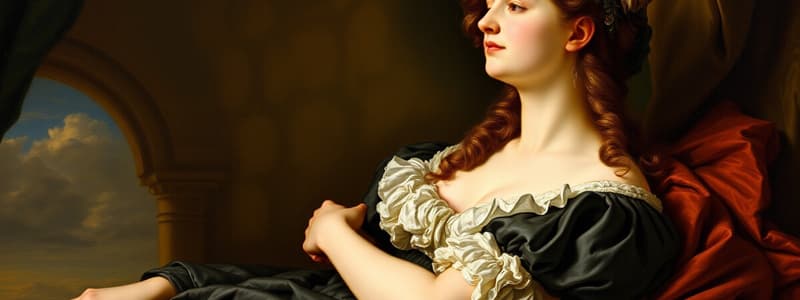Podcast
Questions and Answers
What medium did Artemisia Gentileschi primarily use for her artwork?
What medium did Artemisia Gentileschi primarily use for her artwork?
- Acrylic
- Oil on canvas (correct)
- Watercolor
- Fresco
At what age did Artemisia Gentileschi paint 'Susanna and the Elders'?
At what age did Artemisia Gentileschi paint 'Susanna and the Elders'?
- 17 (correct)
- 15
- 19
- 21
What influence is noted in Gentileschi's artistic style?
What influence is noted in Gentileschi's artistic style?
- Impressionism
- Caravaggio’s use of light and shadow (correct)
- Cubism
- Surrealism
Which family was one of Gentileschi’s patrons?
Which family was one of Gentileschi’s patrons?
What does the wall behind Susanna in the painting symbolize?
What does the wall behind Susanna in the painting symbolize?
What was a key theme in Artemisia Gentileschi's artwork?
What was a key theme in Artemisia Gentileschi's artwork?
What was the significant personal challenge that Gentileschi faced?
What was the significant personal challenge that Gentileschi faced?
Which Biblical book contains the story of Susanna?
Which Biblical book contains the story of Susanna?
What symbolizes modesty and marital fidelity in early representations of Susanna?
What symbolizes modesty and marital fidelity in early representations of Susanna?
What aspect of Susanna's representation evolved in later paintings during the Late Renaissance and Baroque periods?
What aspect of Susanna's representation evolved in later paintings during the Late Renaissance and Baroque periods?
In Catholic liturgy, Susanna is mentioned alongside which of the following?
In Catholic liturgy, Susanna is mentioned alongside which of the following?
What do modern feminist interpreters suggest about the portrayal of Susanna by Gentileschi?
What do modern feminist interpreters suggest about the portrayal of Susanna by Gentileschi?
What was the common theme represented by images of Susanna for early Christians?
What was the common theme represented by images of Susanna for early Christians?
What does Susanna symbolize in early Christian art?
What does Susanna symbolize in early Christian art?
How was Susanna typically depicted by artists in the early phases of her representation?
How was Susanna typically depicted by artists in the early phases of her representation?
What interpretation do modern feminist critics provide regarding Gentileschi's painting of Susanna?
What interpretation do modern feminist critics provide regarding Gentileschi's painting of Susanna?
What aspect of Susanna's representation changed in later Baroque paintings?
What aspect of Susanna's representation changed in later Baroque paintings?
Which characteristic signifies early depictions of figures such as Susanna in catacomb art?
Which characteristic signifies early depictions of figures such as Susanna in catacomb art?
What does the exaggerated S-curve in Susanna's pose signify in the context of the Italian Baroque period?
What does the exaggerated S-curve in Susanna's pose signify in the context of the Italian Baroque period?
How is the public trial of Agostino Tassi significant to understanding Gentileschi's work?
How is the public trial of Agostino Tassi significant to understanding Gentileschi's work?
Which of the following factors contributed to Gentileschi gaining patronage?
Which of the following factors contributed to Gentileschi gaining patronage?
What aspect of Susanna's vulnerability is emphasized in Gentileschi's painting?
What aspect of Susanna's vulnerability is emphasized in Gentileschi's painting?
What influence did Caravaggio have on Artemisia Gentileschi's work?
What influence did Caravaggio have on Artemisia Gentileschi's work?
What is the primary narrative of the story of Susanna found in the book of Daniel?
What is the primary narrative of the story of Susanna found in the book of Daniel?
What does the depiction of the two elders in Gentileschi's painting suggest?
What does the depiction of the two elders in Gentileschi's painting suggest?
How does the portrayal of women in Gentileschi's work contrast with traditional depictions of women in her time?
How does the portrayal of women in Gentileschi's work contrast with traditional depictions of women in her time?
Flashcards are hidden until you start studying
Study Notes
Artemisia Gentileschi
- Italian Baroque painter born in 1593, active until around 1656.
- One of the first female artists to gain recognition in a male-dominated art world.
- Her artwork is characterized by powerful, dramatic compositions, often focusing on strong women from mythology and the Bible.
Early Life and Influences
- Daughter of prominent Roman painter Orazio Gentileschi.
- Displayed artistic talent early and trained in her father's workshop.
- Heavily influenced by Caravaggio's use of chiaroscuro (light and shadow).
Personal Hardships
- Experienced a traumatic rape by Agostino Tassi, a fellow painter in her father's studio.
- The public trial was humiliating and significantly impacted her work, leading to interpretations reflecting her trauma.
Patronage and Recognition
- Gained support from influential patrons, including the Medici family and King Charles I of England.
Notable Work: Susanna and the Elders
- Created in 1610, at the age of 17, this was her earliest known work.
- Depicts Susanna in a contrapposto pose, emphasizing her vulnerability and entrapment.
- The elders' position symbolizes their oppressive scrutiny over her.
Story of Susanna
- The narrative comes from Chapter 13 of the Old Testament book of Daniel, recognized in Roman Catholic and Orthodox traditions but absent from the Jewish Tanakh.
- Susanna, a young Jewish wife, is spied upon while bathing and faces blackmail from the elders who threaten to accuse her of infidelity.
- The prophet Daniel intervenes, exposing the elders' conflicting testimonies, thereby saving Susanna from false accusations.
Symbolism and Interpretation
- Susanna symbolizes modesty and justice; her story has been a popular subject in Christian art since the Early Renaissance.
- Earlier representations depicted her clothed, symbolizing chastity, while later depictions began to show a more relaxed attitude towards her nudity, reflecting societal shifts.
- Gentileschi’s representation contrasts by showing Susanna's fear, potentially reflecting her own experience of harassment and vulnerability.
- Modern feminist interpretations suggest the painting might pre-emptively communicate issues of harassment faced by women, indicating that the artist's perspective brought authenticity to the depiction.
Artemisia Gentileschi
- Italian Baroque painter born in 1593, active until around 1656.
- One of the first female artists to gain recognition in a male-dominated art world.
- Her artwork is characterized by powerful, dramatic compositions, often focusing on strong women from mythology and the Bible.
Early Life and Influences
- Daughter of prominent Roman painter Orazio Gentileschi.
- Displayed artistic talent early and trained in her father's workshop.
- Heavily influenced by Caravaggio's use of chiaroscuro (light and shadow).
Personal Hardships
- Experienced a traumatic rape by Agostino Tassi, a fellow painter in her father's studio.
- The public trial was humiliating and significantly impacted her work, leading to interpretations reflecting her trauma.
Patronage and Recognition
- Gained support from influential patrons, including the Medici family and King Charles I of England.
Notable Work: Susanna and the Elders
- Created in 1610, at the age of 17, this was her earliest known work.
- Depicts Susanna in a contrapposto pose, emphasizing her vulnerability and entrapment.
- The elders' position symbolizes their oppressive scrutiny over her.
Story of Susanna
- The narrative comes from Chapter 13 of the Old Testament book of Daniel, recognized in Roman Catholic and Orthodox traditions but absent from the Jewish Tanakh.
- Susanna, a young Jewish wife, is spied upon while bathing and faces blackmail from the elders who threaten to accuse her of infidelity.
- The prophet Daniel intervenes, exposing the elders' conflicting testimonies, thereby saving Susanna from false accusations.
Symbolism and Interpretation
- Susanna symbolizes modesty and justice; her story has been a popular subject in Christian art since the Early Renaissance.
- Earlier representations depicted her clothed, symbolizing chastity, while later depictions began to show a more relaxed attitude towards her nudity, reflecting societal shifts.
- Gentileschi’s representation contrasts by showing Susanna's fear, potentially reflecting her own experience of harassment and vulnerability.
- Modern feminist interpretations suggest the painting might pre-emptively communicate issues of harassment faced by women, indicating that the artist's perspective brought authenticity to the depiction.
Studying That Suits You
Use AI to generate personalized quizzes and flashcards to suit your learning preferences.




